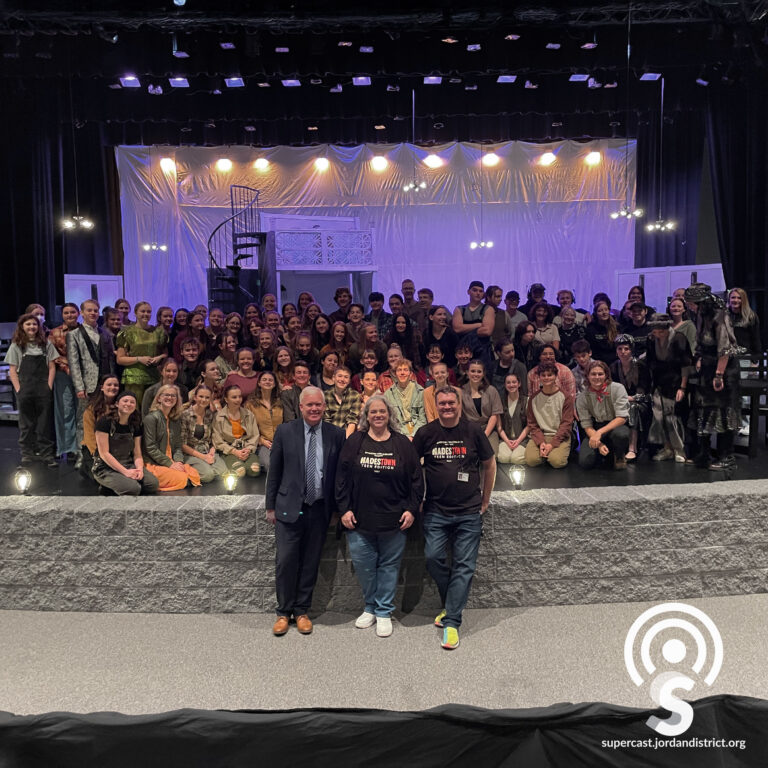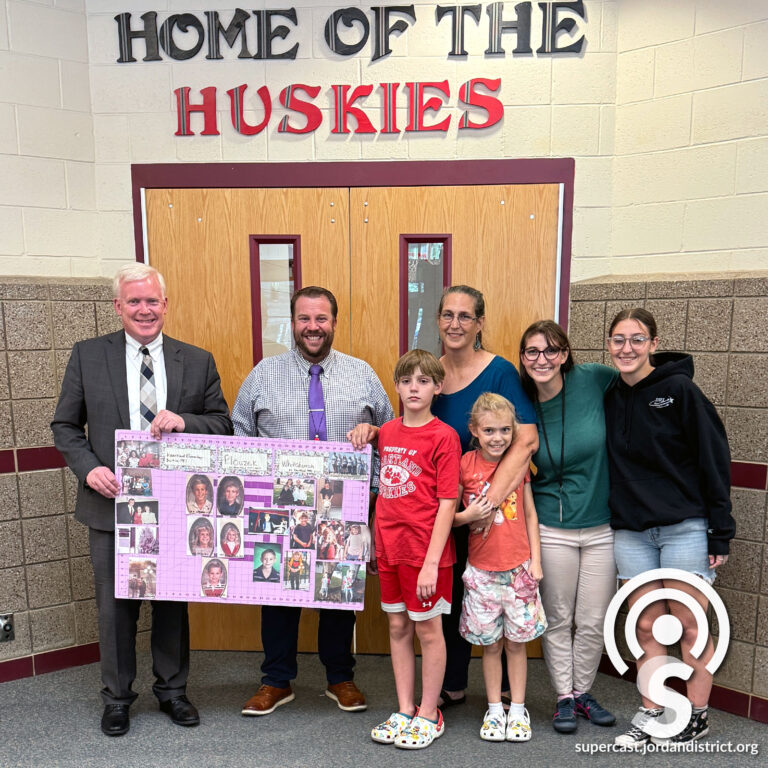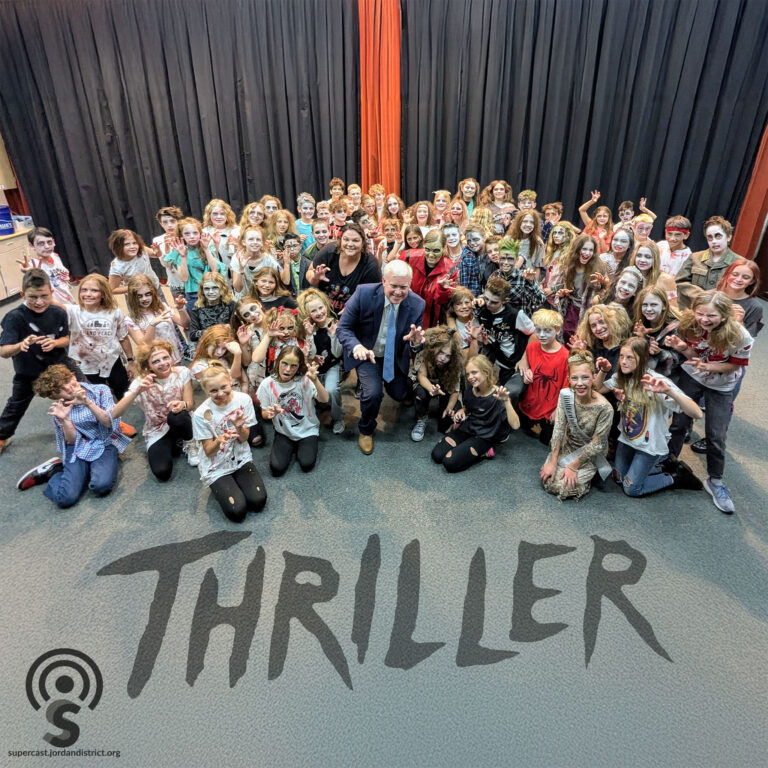He is a Utah Jazz star known for his scoring ability and dynamic style of play on the basketball court. He is also known for his kindness and generosity toward people in the community where he lives.
On this episode of the Supercast, we talk to Jordan Clarkson to hear first-hand why giving back is so important, especially this holiday season. We caught up with Clarkson at Heartland Elementary School where he was providing 250 free Thanksgiving meals to some West Jordan families, grateful for the gift and chance to meet a Jazz superstar.
Audio Transcription
Jordan Clarkson:
I've been in their situation, I've been in their shoes, I'm able to turn around and give back.
Coach Mike Clarkson:
Well, we're very blessed to be able to give back to the community, and this community in particular because he's an active member of the Utah Jazz. Jordan has always been very generous with his time, with his resources, and his heart.
Anthony Godfrey:
Hello and welcome to the Supercast. I'm your host, Superintendent Anthony Godfrey. He is a Utah Jazz star known for his scoring ability and dynamic style of play. He's also known for his kindness and generosity in the community.
On this episode of the Supercast, we talk with Jordan Clarkson to hear first-hand why giving back is so important, especially this holiday season. Listen as we catch up with Clarkson and his family at Heartland Elementary School, where he was providing 250 Thanksgiving meals to West Jordan families in need. Families who are grateful for the gift and the chance to meet a Jazz superstar.
[music]Coach Mike Clarkson:
I just want to say on behalf of the Clarkson family, Jordan, and the JC Cares Foundation, thank you for volunteering to help us. Our family is committed to always giving back. We've done it before Jordan made it to the league. It will never stop. Hopefully, we'll be ingrained in our sons and they'll continue to do it as we pass on. But again, I'd like to thank you all. It means a lot. You may not think it means a lot, but it means a lot to those that need help. And that's what we're all here to do. I really appreciate you guys and the time that you guys commit to do that because time is the most valuable asset that we have being human beings.
Anthony Godfrey:
We're talking with Coach Mike Clarkson, who is associated with JC Cares and is here to help organize this effort. Your son Jordan is on his way. Tell me about this event here today.
Coach Mike Clarkson:
Well, we're very blessed to be able to give back to the community and this community in particular because he's an active member of the Utah Jazz. Jordan has always been very generous with his time, with his resources, and his heart. We really appreciate the opportunity to work with this school district and to be able to touch families that might not be touched and have a nice holiday. It's very important at Thanksgiving that we do give thanks. But it's more important also that we reach out to those in need and those that can really benefit from our generosity.
Anthony Godfrey:
You just gave a stirring pep talk for the volunteers here and letting them know the importance of what they're doing for the community here. What does it mean to you to see this level of support?
Coach Mike Clarkson:
Well, having grown up impoverished, in Washington, DC as a young man, I didn't get the support that I see my son willing to go out and provide an opportunity to provide for others. It's heartwarming to me because I know anyone can turn their back on you. Very few people are willing to help you. And in life when you're able to find someone or some organization or entity that will help and assist you, that goes a long way in your life in inspiring you and to give you some sense of hope and belief that good is out there in the world.
Anthony Godfrey:
Well, the foundation was here last year.
Coach Mike Clarkson:
Yes, sir.
Anthony Godfrey:
All of you were here doing the same thing and it's built a lot of momentum, very successful, and we're excited to see what happens this year as well.
Coach Mike Clarkson:
Yes, sir.
Anthony Godfrey:
What impact do you hope this has on the families who come today and get to meet you and your family and receive this meal?
Coach Mike Clarkson:
The biggest thing is to understand that people care. That's what it's called, JC Cares. It's always this time of year when people struggle, families struggle, and they feel a sense of hopelessness. And we hope that the little that we do for them can inspire them to go out and not only better themselves, but to at one point in time turn around and give back to society. Because everything is about hope and if you're not inspired to achieve, what do you have?
Anthony Godfrey:
I think that's exactly the word for it. It inspires people and says, "Hey, wait a minute. There are people who care. There are people here supporting me. So maybe I can do some things I didn't think I could do on my own."
Coach Mike Clarkson:
Yes, sir. And I think I get so much joy out of looking at someone's face when they know somebody cares about them. That's something that Jordan has been able to understand. We've preached that for many years, but to see your child grow up and to have the opportunity he has, and to now regurgitate and to go out and exercise and practice what you taught them, it's nothing more rewarding than that, sir.
Anthony Godfrey:
That's wonderful. That's beautiful because it's not automatic.
Coach Mike Clarkson:
Correct.
Anthony Godfrey:
It's not automatic that you're successful and now you do this sort of thing. And to see Jordan, like you said, living out the things you taught him as a child, that's got to be a thrill.
Coach Mike Clarkson:
Yes, yes. That warms my heart more than anything because I always say, "It's not about what you have, but as God says, are you a good steward with what you have?" And Jordan has learned about the value and the importance of being a good steward.
Anthony Godfrey:
Well, we're so grateful to have him here today, and to have you and our community helping support this. So thank you very much.
Coach Mike Clarkson:
Thank you for the opportunity.
Anthony Godfrey:
And happy Thanksgiving to you.
Coach Mike Clarkson:
Same to you and all the families out there, sir.
Anthony Godfrey:
Thank you. Take care.
Stay with us. When we come back, we'll talk with Jordan Clarkson about why he gives back and what his plans are for Thanksgiving.
Never miss an episode of the Supercast by liking and subscribing on your favorite podcasting platform. Find transcripts for this episode and others at supercast.jordandistrict.org.
Break:
Are you looking for a job right now? Looking to work in a fun and supportive environment with great pay and a rewarding career? Jordan School District is hiring. We're currently filling full and part-time positions. You can work and make a difference in young lives and education as a classroom assistant or a substitute teacher. Apply to work in one of our school cafeterias where our lunch staff serves up big smiles with great food every day. We're also looking to hire custodians and bus drivers. In Jordan School District we like to say people come for the job and enjoy the adventure. Apply today at employment.jordandistrict.org
Anthony Godfrey:
We're here with Jordan Clarkson for the JC Cares event. Tell me a little bit about why this is so important to you.
Jordan Clarkson:
Just for us to give back for all the kids. I've been in their situation. I've been in their shoes. For our family, I'm blessed to be in this position now that I'm able to turn around and give back some. I'm here. I was in their place. We're here now.
Anthony Godfrey:
I was able to talk with your parents and it sounds like they had a real emphasis on making sure that as a family, you always give back. Tell me about the impact your parents have had on you in putting this together.
Jordan Clarkson:
They run my whole foundation. I think they feel in a sense that we are blessed. I'm one of one. We all sat there as kids and family and fought together through tough times and whatever it was. This is one of those situations that we've all been through and we're just here to give a helping hand. Some people when we were growing up didn't reach out and have that impact on us.
Anthony Godfrey:
How do you hope people feel coming out of this as they come, get to meet you and your family and people in the community, and come away with a meal? What impact do you hope that has on them?
Jordan Clarkson:
Just smiles. That's it. Just great joy. That's all we ask for. Keep continuing to have good vibes. That's all we're trying to spread and that's the joy we want.
Anthony Godfrey:
Thank you very much. Thanks for doing it here at Heartland and for helping support so many people and supporting the community at large. Tell me, do you at least get Thanksgiving off? Did Coach give you the day off?
Jordan Clarkson:
I don't know. Maybe me, but just because.
Anthony Godfrey:
With the injury?
Jordan Clarkson:
Yeah, yeah.
Anthony Godfrey:
You'd rather be on the court.
Jordan Clarkson:
Yeah, exactly. I'm the biggest cook, so I'm going to be working no matter what.
Anthony Godfrey:
You're the biggest cook?
Jordan Clarkson:
Yeah.
Anthony Godfrey:
What's your specialty dish?
Jordan Clarkson:
My specialty is I really cook steak and brisket. I'm good at doing it.
Anthony Godfrey:
Steak? Wow.
Jordan Clarkson:
And brisket and I fry turkey, man. I go in there, I sit outside. My thing in the garage.
Anthony Godfrey:
So you got the three meats going?
Jordan Clarkson:
Yeah.
Anthony Godfrey:
All from you, huh?
Jordan Clarkson:
All from me, yeah.
Anthony Godfrey:
Oh, that's awesome. Well, congratulations on your career. Thank you so much for making us a part of your day today.
We're here today talking with two of the people associated with the JC Cares Foundation. Introduce yourself and tell us a little bit about what's happening today.
Ken:
Hey, my name is Ken. I help manage Jordan and his day-to-day and some of the give back initiatives that we do with Team Clarkson and his JC Cares Foundation.
Janie Clarkson:
Janie Clarkson, basically what I do is help him out with all his philanthropic, you know, making sure that, you know, we get back to the community and to be here to support in everything that he does.
Anthony Godfrey:
Tell me about Jordan growing up. Did you know that he was going to be someone who would be associated with helping others out and making sure that they had the support they needed?
Janie Clarkson:
Yes, because we've always made sure that, you know, he gives back, not just him and himself, but the family to being part of that as well. It's big in our family to make sure that we look out for other people and for them to do well and to be also successful in life.
Anthony Godfrey:
It's wonderful to have you all here today and to have the support for the community. Tell us about what's happening today. Families are coming in that are in need and receiving a meal for Thanksgiving.
Ken:
Yeah, we're excited about it. This is our third year doing it in Utah, our second year doing it here at this location. They're able to come in and get everything, not just the turkey, they're able to get the fixings to go along with it. A full meal, you know, from start to finish. I feel like that's really important because having a turkey just by itself, you know, doesn't feel like Thanksgiving, but having all the sides, like that's what makes it.
Anthony Godfrey:
It's the full meal, but it's also a chance to connect with Jordan, with you, with the family and feel a part of the community. And last but not least, Santa's on the way out the door. You get to stop by and see Santa.
Ken:
You get to stop by and see Santa. I think, you know, it's a small part of our day to give back and I feel like it makes a huge impact for the families that come in and get to receive. You know, who knows what they're going through. We all get to go back home. We have our families. Some people aren't as fortunate, you know, so it means a lot.
Anthony Godfrey:
Well, we appreciate the chance to be part of it and to house this here today. I know that there are people benefiting from around the community. So thank you very much for doing that.
Janie Clarkson:
Thank you for supporting him.
Ken:
Thank you.
Anthony Godfrey:
Thanks for joining us on another episode of the Supercast. Remember, education is the most important thing you will do today. We'll see you out there.
(Music)





